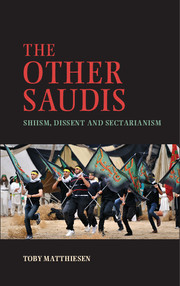Book contents
- Frontmatter
- Dedication
- Contents
- List of Maps and Pictures
- Acknowledgements
- A Note on Conventions
- Glossary
- Abbreviations
- Map
- Introduction
- 1 Politics of Notables
- 2 Oil and Dissent
- 3 Shia Islamism
- 4 A Decade of Confrontation
- 5 No More Revolution
- 6 Marginal Recognition
- 7 A New Intifada
- Conclusion The Politics of Sectarianism
- Bibliography
- Index
- References
1 - Politics of Notables
Published online by Cambridge University Press: 05 December 2014
- Frontmatter
- Dedication
- Contents
- List of Maps and Pictures
- Acknowledgements
- A Note on Conventions
- Glossary
- Abbreviations
- Map
- Introduction
- 1 Politics of Notables
- 2 Oil and Dissent
- 3 Shia Islamism
- 4 A Decade of Confrontation
- 5 No More Revolution
- 6 Marginal Recognition
- 7 A New Intifada
- Conclusion The Politics of Sectarianism
- Bibliography
- Index
- References
Summary
Are we not Muslims? And if we are not Muslims … then are we not citizens?
Letter by Shia notables to King Fahd, 5 January 1992Shia Islam in Eastern Arabia
Several histories of the Shia of al-Ahsa, Qatif and Bahrain trace their lineage to the partially Christian tribe ʿAbd al-Qays that entered Bahrain and Qatif in the sixth century. Branches of the ʿAbd al-Qays participated in the conquests of the Muslim forces and espoused the cause of ʿAli. The Qarmatians, a Sevener Shia Ismaili movement, ruled Eastern Arabia from 899 until the late eleventh century. This contributed to a distinct sense of religious identity that differed from that of the interior of the Arabian Peninsula. Twentieth century Shia identity entrepreneurs depict this period of ‘ancient Bahrain’ as the golden age of the Shia of Eastern Arabia, effectively formulating a ‘Bahrani nativism’. Bahrani is a term that refers to the native, mainly Arab Shia, inhabitants of Bahrain, Qatif, and to a lesser extent al-Ahsa. An early 20th century British source, for example, uses the term Bahrani to describe Shia of Qatif, but the term has become less common in al-Ahsa and Qatif, while it remains widely used in Bahrain.
The political union between Qatif, al-Ahsa and the islands of Bahrain, which is key to the idea of an ‘ancient Bahrain’, existed for most of the time between the ninth and the fifteenth century. After the Qarmatians, from the late eleventh to the middle of the sixteenth century, local tribal dynasties ruled the lands of Bahrain and had their capitals at times on the island of Bahrain and at times in Qatif or al-Ahsa. Until the early fourteenth century, the tribal dynasties in al-Ahsa were Sunni, and thereafter Shia. In 1515, the Portuguese took Hormuz and five years later a joint Portuguese-Hormuzi naval force conquered Qatif and Bahrain.
- Type
- Chapter
- Information
- The Other SaudisShiism, Dissent and Sectarianism, pp. 24 - 65Publisher: Cambridge University PressPrint publication year: 2014

